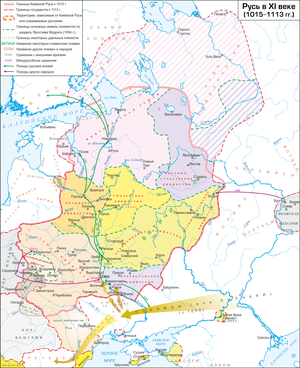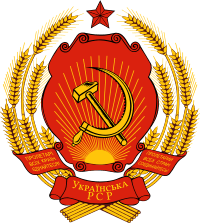Principality of Turov
The Principality of Turov, also called Principality of Turov and Pinsk (Belarusian: Турава-Пінскае княства, Russian: Турово-Пинское княжество, Ukrainian: Турово-Пінське князівство) or Turovian Rus',[1] was a medieval East Slavic principality and important subdivision of Kievan Rus' since the 10th century on the territory of modern southern Belarus and northern Ukraine. Princes of Turov often served as the Grand Princes of Rus early in 10th-11th centuries. The principality's capital was Turov (now called Turaŭ) and other important cities were Pinsk, Mazyr, Slutsk, Lutsk, Berestia, and Volodymyr.
Principality of Turov and Pinsk | |||||||||
|---|---|---|---|---|---|---|---|---|---|
| 10th century–14th century | |||||||||
 | |||||||||
| Status | Part of the Kievan Rus | ||||||||
| Capital | Turov | ||||||||
| Common languages | Old East Slavic | ||||||||
| Religion | Eastern Orthodox Church | ||||||||
| Government | Monarchy | ||||||||
| Prince of Turov | |||||||||
• 950-980 | Tur | ||||||||
| Legislature | Veche | ||||||||
| History | |||||||||
• Established | 10th century | ||||||||
• Incorporation into the Grand Duchy of Lithuania | 14th century | ||||||||
| |||||||||
Until the 12th century the principality was very closely associated with the principalities of Kiev and Volhynia. Later for a short period time until the Mongol invasion it enjoyed a wide degree of autonomy when it was annexed to the Kingdom of Rus. In the 14th century it became part of the Grand Duchy of Lithuania, Ruthenia and Samogitia.
History
The Principality of Turov originated mainly from the Dregovich tribe and partially the Drevlyans. While circumstances of its creation are not clearly known, the Principality as mentioned in the Primary Chronicle existed in 980. According to the legend, the town of Turaŭ was founded around 950 (first mentioned in 980) by Varangian Prince Tur, a brother of Rogvolod (the first chronicled prince of Polatsk).[2]
Kiev Principality
During the times of Vladimir the Great (980 - 1015), the city of Turov and the immediate vicinity became part of Kievan Rus. Around 988, Vladimir appointed his eight-year-old son, Sviatopolk I of Kiev, to be knyaz of Turov. Later, Vladimir jailed Sviatopolk for plotting to rebel. Shortly before Vladimir died, Sviatopolk was freed and, upon Vladimir's death, seized the mantle of Grand Prince of Rus.
Izyaslavichi
In a series of three battles during 1016-1018, Yaroslav the Wise overthrew his older brother, Svyatopolk, and became Grand Prince of Kievan Rus. About 1042 or 1043, Yaroslav married his eldest son, Izyaslav, to the sister of King Casimir I of Poland and appointed Izyaslav to be knyaz of Turov and Pinsk. In 1054, Izyaslav became Grand Prince of Rus, with a volatile reign.
In 1078 after Izyaslav's death, Isyaslav's brother and new Grand Prince, Vsevolod, appointed Izyaslav's eldest son, Yaropolk Izyaslavich to be knyaz of both Volhynia and Turov. In 1084, the Rostislavichi, rulers of neighboring Galicia (Halychyna), attempted to seize part of Yaropolk's realm, but Yaropolk and Vsevolod's son, Vladimir Monomakh, defeated the invaders. Yaropolk revolted briefly against Grand Prince Vsevolod, was reinstated, and was murdered in 1087 (likely by the Rostislavichi).
Opposition to Vladimir Monomakh
The Turov principality was passed to his younger brother Sviatopolk II who administered the land of Novgorod. When Svyatopolk became the Grand Prince of Rus, he passed the principality of Turov to his nephew and son of Yaropolk Vyacheslav. Later Svyatopolk gave Volodymyr-Volynskyi and Brest to his sons Yaroslav and Mstislav respectively. As the Grand Prince Svyatopolk also tried to conquer the rebellious Rostislvichi who established themselves well in the land of Halych. However, his attempts were rather unsuccessful. In 1100 the principality of Turov was passed to Yaroslav Svyatopolkovich who ruled both lands of Turov and Volhynia. During another conflict between the prince of Turov and the Grand Prince of Rus Yaroslav was eliminated out of his realm in 1118. The land of Turov then was passed to another son of Svyatopolk Bryachislav, while Volhynia was given to one of the sons of Vladimir Monomakh Roman.
The 1097 Council of Liubech modified the rota system such that the Principality became patrimonial land.
Reinstatement
After the death of Bryachislav Vladimir, Monomakh gave the Turov principality to his Vyacheslav who kept it until the middle of the 12th century. Around the 1150s Turov belonged to the descendants of Yuri Dolgoruki Andrei and Boris. Finally in 1162 the principality was passed by Yuri Dolgoruki back to one of the Izyaslavichi Yury Yaroslavich, grandson of Svyatopolk II of Kiev, who gained full independence from Kievan Rus'. However, at the same time the Principality became more and more divided between several sons of the duke Yury. A semi-independent Principality of Pinsk was created. Along with the Principality of Smolensk, the army of Turau participated in the Battle of the Kalka River in 1223.
Decline
In the early 13th century the Principality of Turov became dependent of the Kingdom of Galicia–Volhynia. To liberate itself from it, the dukes of Turov cooperated more and more with the Grand Duchy of Lithuania. In the early 14th century the Principality non-violently joined the Grand Duchy. By that time Hleb Narymunt, the son of Gediminas, was already ruler of Pinsk, while Turov and Haradok were still ruled by Rurikids. Later the territory of the Principality became part of Brest Litovsk, Nowogródek, and Minsk Voivodeships.
Regions of the Principality
- Principality of Turov (10th century - 14th century)
- Principality of Pinsk (12th century - 16th century)
- Principality of Kletsk (12th century - 15th century)
- Principality of Slutsk-Kopyl (12th century - 16th century)
- Principality of Dubrovytsia (12th century - 13th century)
Leaders
Part of a series on the |
|---|
| History of Belarus |
| Prehistory |
| Middle ages |
| Early Modern |
|
| Modern |
|
|
|
Part of a series on the |
|---|
| History of Ukraine |
   |
|
Early history
|
|
Modern history
|
|
Topics by history |
|
|
Prince of Turov
- Sviatopolk I Accursed (980-1019)
- Izyalavichi
- Izyaslav I Yaroslavich (about 1045-1078)
- Yaropolk Petr Izyaslavich(1078–1087)
- Sviatopolk II Mikhail Izyaslavich (1087–1094)
- Vyacheslav Yaropolkovich (1094-1104/1105|5)
- Monomakh (of Smolensk)
- Vyacheslav Monomakhovich (1125–1132)
- Izyaslav II Monomakhovich (1133–1134)
- Vyacheslav Monomakhovich (1134–1141)
- Vyacheslav Monomakhovich (1142–1146)
- ?
- Dolgoruky
- Andrei I Yuryevich (1150–1151)
- ?
- Borys I (1155–1157)
- Yuryevichi (Izyaslavichi's branch)
- Yuri Yaroslavovich (1157–1167)
- Ivan Yuryevich (1167–1190)
- Gleb (1190–1195)
- Ivan Yuryevich (1195–1207)
- Rostislav Glebovich (1207–1228)
- ?
- Yuri Volodymyrovich (?-1292)
- Dmitry Yuryevich (1292-)
- Danila Dmitrovich (?-before 1366)
Prince of Pinsk
- Yuryevichi (Izyaslavichi's branch)
- Jarosław Juriewicz (-1184-)
- Włodzimierz Glebowicz (-1228-)
- Rościsław Włodzimierzowicz (-1242-)
- Fiodor Włodzimierzowicz (-1262-)
- Jerzy Włodzimierzowicz (-1292)
- Demid Włodzimierzowicz (1292-to 1292)
- Jarosław Juriewicz (to 1292-)
- Jerzy Dymitrowicz
- Giedymin (1320- ?)
- Narymunt Gleb (1340–1348)
- Michał Glebowicz Narymuntowicz (1348-?)
- Wasyl Michajłowicz Narymuntowicz (14th century)
- Jerzy Nos Wasylewicz Narymuntowicz (before 1398- after 1410)
- Jerzy Semenowicz (before 1440-after 1471)
- Maria Olelkowicz (1471–1501)
- Wasyl Olelkowicz (1480–1495)
- Fiodor Iwanowicz Jarosławicz (1501–1521)
Prince of Kletsk
- Yuryevichi (Izyaslavichi's branch)
- Wiaczesław Jarosławicz (1127- ?)
- ?
- Michał Zygmuntowicz (1442–1452)
Prince of Slutsk-Kopyl
- Jarosław Izasławowicz ? (1148)
- Światosław Olegowicz (1148–1162
- Włodzimierz Mścisławowicz (1162–1164) ?
- ?
- Włodzimierz Olgierdowicz (1395–1398)
- Aleksander Olelko (1398–1454)
- Michał Olelkowicz (1454-1470/1481)
- Szymon I Olelkowicz (1481–1505)
- Jerzy I Olelkowicz (1505–1542)
- Szymon II Olelkowicz (1542–1560)
- Jerzy II Olelkowicz (1560–1572)
- Jerzy III Olelkowicz (1572–1586)
Prince of Dubrovytsia
- Iwan Juriewicz (1166–1182) ?
- Gleb Juriewicz (1182–1190)
- Aleksander Glebowicz (1190–1223)
References
- Jan Tyszkiewicz (2015): The stronghold in Sypniewo from the 10th–11th century (p. 295)
- Franklin, Simon; Shepard, Jonathan (2014). The Emergence of Rus 750-1200. Longman History of Russia. Routledge. ISBN 9781317872245.
There arrived 'from overseas' a certain Rogvolod (Ragnvaldr in Old Norse). He installed himself on the Western Dvina at Polotsk, reportedly enjoying princely status. Likewise, Tur or Tury set himself up in a promontory fort by the Pripet, staying there long enough to leave his name on the place, Turov. It seems to have been a recent foundation, if not his own.
Bibliography and external links
- Primary Chronicle
- Ermolovich M.I., Ancient Belarus - Polotsk and Novogrudskii period, 1990 (Ермаловіч М. І. Старажытная Беларусь. Полацкі і Навагародскі перыяд. Мн., 1990.) (in Belarusian)
- Saganovich G., Outline of the History of Belarus from antiquity to the end of 18th century (Сагановіч Г. Нарыс гісторыі Беларусі ад старажытнасці да канца XVIII ст. Мн., 2001.) (in Belarusian)
- Hrushevsky, M. "History of Ukraine-Rus". Vol.2 Ch.4 (page 5) (in Ukrainian)
.svg.png)